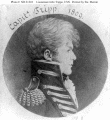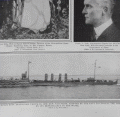Click On Image
For Full Size Image |
Size |
Image Description |
Contributed
By And/Or Copyright |
 |
86k | John Trippe was born in 1785 in Dorchester County, Md. He was appointed a midshipman in the Navy on 5 April 1799. During the Quasi-War with France, he made his first cruise in the frigate Constitution and later served in the schooner Experiment. On 21 May, he was assigned to Commodore Richard Dale's flagship President, and he served in her until early 1802 in operations against the Tripolitan corsairs in the Mediterranean. He returned to the United States in April 1802 and received a furlough to make a mercantile voyage. On 24 May 1803, the Navy Department ordered Trippe to Vixen as an acting lieutenant. The schooner sailed for the Mediterranean on 3 August and joined Commodore Preble's squadron off Tripoli on 14 September 1803. Lt. Trippe served with distinction in the Mediterranean until the fall of 1805. On 3 August 1804, he led his crew of Gunboat No. 6, manned by another midshipman and nine sailors, to victory over the 36-man crew of a large Tripolitan boat. Trippe and his men boarded the enemy, and Trippe himself grappled with the leader of the pirates. Though his adversary towered over him, Lt. Trippe used his own agility and tenaci ty to emerge victorious in a desperate hand-to-hand struggle. Seriously wounded, he was unable to participate in the next three of Preble's five attacks on Tripoli. However, by the beginning of September, he had recovered sufficiently to resume command of Gunboat No. 6 for the fifth and final assault carried out on the 3d. For his gallantry in action against the Barbary pirates, Lt. Trippe received a sword and a commendation from Congress. Trippe returned to the United States in November 1805, but 1806 found him back on duty in the Mediterranean. In 1808, Trippe served at Charleston, S.C., enforcing the embargo legislation. He took command of Enterprise on 23 January 1809, departed New York on 24 June, and headed for Holland. On 31 July, he reached Amsterdam, where he delivered official dispatches and conducted negotiations which helped cement commercial relations between The Netherlands and the United States. Having helped open Dutch ports to American shipping, he weighed anchor on 10 October and reentered New York harbor on 2 December. On 26 April, Trippe transferred to the command of Vixen and, a month later, departed New Castle, Del., bound for New Orleans. Off Stirrup Key on 24 June, Vixen came under the fire of a British ship, HMS Moselle. When summoned on board the Britisher, Trippe refused, cleared Vixen for action, and demanded an explanation of Moselle's untoward action. Her captain responded with an apology, stating that he had mistaken the American man-of-war for a Frenchman. Vixen then continued peacefully on her way and put into Havana, Cuba, six days later. On 9 July 1810, while en route from Havana to New Orleans, Lt. Trippe died. Photo #: NH 61303. Lieutenant John Trippe, U.S. Navy, (1785-1810) engraved portrait by Charles Ste. Memin, 1809.
Trippe was Commanding Officer of the U.S. Schooner Enterprise in that year. Courtesy of the U.S. Navy Art Collection, Washington, D.C. U.S. Naval Historical Center Photograph. | Tony Cowart/Robert M. Cieri |
 |
85k | USS Trippe (Destroyer # 33) Underway in 1912. Photographed by O.W. Waterman, Hampton, Virginia. Courtesy of the Naval Historical Foundation. U.S. Naval Historical Center Photograph. | Fred Weiss |
 |
70k | USS Trippe (DD-33) in the Hudson River, off New York, City, during the October 1912 Naval Review. A torpedo boat is visible beyond her bow. Note that the original print misidentifies the Trippe as USS Monaghan (DD-32). | Robert Hurst |
 |
108k | Newspaper clipping from September 5, 1915 captioned; "U. S. TORPEDO BOAT DESTROYER TRIPPE IN HER NEW WAR PAINT, ADOPTED BY THE BY ITS RESEMBLANCE TO THE WAVES." Photo by Waterman. | Michael Mohl |
 |
3217k | A very large newspaper clipping of the USS Barry (DD-2), USS Tripp (DD-33), USS Aylwin (DD-47) and the USS McDougal (DD-54) from the Baltimore Sun dated September 12 1915. | Mike Mohl |
 |
16k | Newspaper clipping from the New York Times, April 8 1917 (Page 1), "U.S. Torpedo boat destroyer on guard before the ships of the Hamburg American Line & North German Lloyd liners lying at their berth in Hoboken N.J. Photo by Underwood & Underwood. | Michael Mohl |
 |
103k | USS Trippe (Destroyer # 33) At a mooring buoy with another destroyer alongside, at Queenstown, Ireland, circa 1918. Note her pattern camouflage scheme. U.S. Naval Historical Center Photograph. | Fred Weiss |
 |
67k | USS Trippe (Destroyer # 33) At her moorings, circa 1918, probably in a British Isles harbor. Note her pattern camouflage. Photograph from the Army Signal Corps Collection in the U.S. National Archives. | Fred Weiss |
 |
82k | USS Trippe (Destroyer # 33) Deparing Queenstown, Ireland, for the United States in December 1918. Note her long "homeward bound" pennant, and man waving his cap from atop Trippe's stern depth charge rack. U.S. Naval Historical Center Photograph. | Fred Weiss |

0503313 |
173k | Destroyers of "Flotilla B' nested together, probably at Charleston, SC, late 1918/early 1919. Trippe (Destroyer no. 33) is in foreground. | Dave Wright |
 |
121k | In Key West, circa 1919. | Jim Brooks, NAS Key West Public Affairs Officer |
 |
23k | On Coast Guard service during the Prohibition Era, from the Official Coast Guard Website. | Mike Green |
 |
175k | 1928 photo of United States Coast Guard destroyers moored at New London, Connecticut. All are former US Navy destroyers loaned to the Coast Guard for Prohibition Service. Shown here are the Trippe (CG-20/DD-33), Wainwright (CG-24/DD-62), Downes (CG-4/DD-45), Beale (CG-9/DD-40) and Abel P. Upshur (CG-15/DD-193). Source: National Aviation Museum Collection, Photo No. 2009.006.001. | Mike Green |

